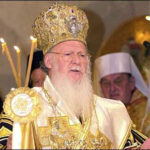The Eastern Orthodox Church
Article by Paul Negrut at the CRI website (original source here)
The Eastern Orthodox Church- SYNOPSIS
Recent years have witnessed a surge of Western Christians joining the Orthodox Church. With its emphasis on mystical union with God, its rich history, and its beautiful icons (sacred images) and liturgies, Orthodoxy appeals to those who long for a deeper sense of wonder in their worship and faith. Yet behind the appeal lie some hard realities. The Orthodox world is not monolithic, and one cannot become Orthodox in general. The Orthodox tradition is not entirely apostolic, and consequently the claim to represent the true church of Christ is triumphalistic. Orthodoxy follows a different theological paradigm; for example, within Orthodoxy the doctrine of salvation has a different meaning than within Catholicism or Protestantism. Protestant evangelicals who have joined the Orthodox church often display an inadequate understanding of the faith they have embraced.
In 1987, some 2,000 laypersons and clergy from 17 churches, including Lutherans, Pentecostals, Baptists, Independents, and others, embraced the Orthodox faith.1 These new converts explained that the day they joined the Orthodox church was the glorious end of a long journey to find the true church of Christ. In the foreword to Peter Gillquist’s book, Becoming Orthodox, Bishop Maximos Agiorgoussis argued, The researchers had no difficulty in realizing thatthe only body which meets the criteria of the Church founded by Christ, the Church of apostolic tradition, faith and practice, is today’s Holy Orthodox Church of Christ.2
Metropolitan Philip Saliba, head of the Antiochian Orthodox Churches of North America, hailed the event as having historic significance: Not in your lifetime, not in my lifetime, have we ever witnessed such a mass conversion to Holy Orthodoxy. Then he added, Last week I said to evangelicals, ‘Welcome home!’ Today I am saying, ‘Come home, America! Come home to the faith of Peter and Paul.’3
Another speaker proclaimed, Our fathers embraced this Orthodox Christian faith and brought it to America. Now it’s our turn to bring America — and the West — to Orthodox Christianity.4 Since 1987 many others have followed the Eastern trail. Some well-known apologists of this new trend are urging the Orthodox to mount a crusade to win America to Christ.5 Reading such claims, one cannot avoid asking if such statements are based on solid historical and theological arguments or if this movement is yet another religious diversion.
The Eastern Orthodox Church- ORTHODOX FAITH OR FAITHS?
In Becoming Orthodox, Peter Gillquist asserts, The Orthodox churchmiraculously carries today the same faith and life of the Church of the New Testament.6 The presupposition behind this statement is that the Orthodox church is a unified body that speaks with one voice. In fact, Orthodoxy is not a monolithic bloc that shares a unified tradition and church life. The phrase Eastern Orthodoxy, commonly used to describe the Orthodox faith, actually refers to the dominant churches of Eastern Europe. In a broad sense, the Eastern tradition comprises all the Christian churches that separated at an early stage from the Western tradition (Rome) in order to follow one of the ancient patriarchies (Jerusalem, Antioch, Alexandria, and Constantinople).
During the twentieth century, these churches not only have spread throughout all continents, but also have penetrated many cultures that have not been traditionally associated with the Eastern tradition. Generally speaking, these churches can be grouped into one of the following:
1.The Orthodox churches in the Middle East. These belong to the most ancient oriental ecclesiastical units, and they include the Patriarchies of Constantinople (modern Istanbul), Alexandria (Egypt), Antioch (Syria and Lebanon), Jerusalem (Jordan and the occupied territories), the Armenian Catholicossates of Etchmiadzin (former Soviet Republic) and Cilicia (Lebanon), the Coptic Orthodox church (Egypt), and the Syrian Orthodox church (Syria, Beirut, and India).7
2.The Orthodox Churches in Central and Eastern Europe. Both culturally and theologically, these churches follow closely the Byzantine (Constantinopolitan) tradition. Generally known as Eastern Orthodoxy, they include the autonomous churches of Russia, Romania, Serbia, Greece, Bulgaria, Georgia, Cyprus, the Czech Republic, Slovakia, Poland, Albania, and Sinai.8
3.The Orthodox Diaspora. Organized outside the traditional Orthodox countries, these ecclesiastical communities are found in Western Europe, North and South America, Africa, Japan, China, and Australia.
These churches have significant theological, ecclesiastical, and cultural differences among themselves. For example, the fifth-century Monophysite controversy over whether Christ has two natures or one separated the Byzantine church from the ancient Eastern churches. Furthermore, the Eastern churches disagree on the date for Easter and the legitimacy of church hierarchy and sacraments. As a result of such differences, the Eastern churches have parallel ecclesiastical structures not only in the same country but even in the same city, thus disregarding the rule of one bishop in one city. Continue reading →
 Dr. Sam Storms: (original source here)
Dr. Sam Storms: (original source here)
 Article: How Is Eastern Orthodoxy Different? by Dr. D. Trent Hyatt (original source
Article: How Is Eastern Orthodoxy Different? by Dr. D. Trent Hyatt (original source